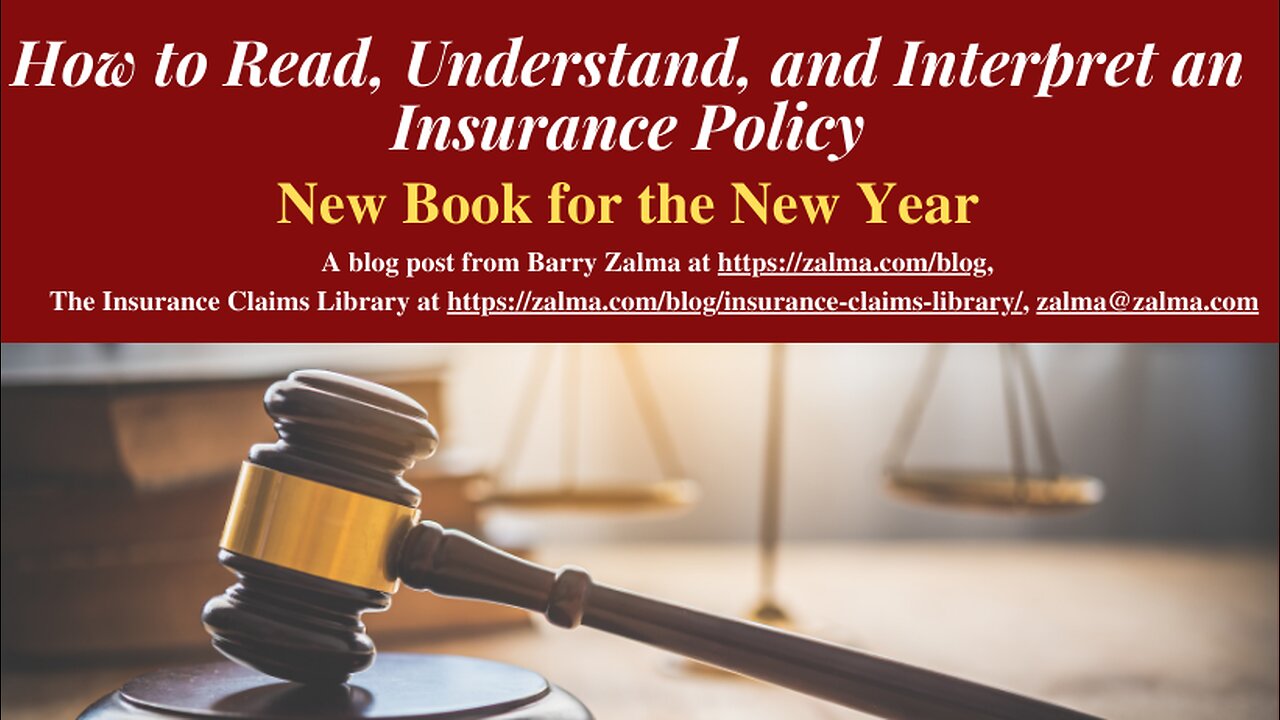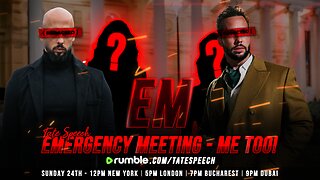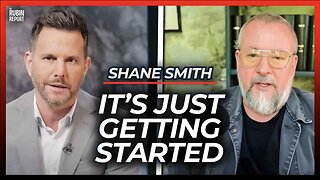Premium Only Content

How to Read, Understand, and Interpret an Insurance Policy
New Book for the New Year
To start off the New Year I published my newest insurance coverage and claims book entitled: A Compact Book on How Judges Read, Understand, Interpret and Rule on Insurance Policy Issues: Every Person Who is Insured Needs to Understand How Judges interpret Insurance Policies.
The book provides those who are insured, insurance claims people, insurance claims executives, underwriters, insurance agents, insurance brokers, insurance coverage lawyers and policyholders lawyers an ability to understand how they should emulate the courts when interpreting an insurance policy to avoid taking untenable positions with regard to claims.
Understanding the Terms and Conditions of an Insurance Policy
The challenge faced by every person insured when making a claim is to determine what was insured and what was not insured. Similarly, every insurance claim professional when faced with the need to resolve a claim presented by an insured is required to determine if the insurance policy, by its wording, provides coverage to indemnify the insured or does not. To do so the insured and the insurance claim professional must read, understand, and interpret the policy and apply the wording of the policy to the facts determined by the claims investigation.
To present or investigate a claim fairly both those insured and those representing the insurer must understand what insurance is and its history of indemnifying those who incur losses as a result of a fortuitous event.
An insurance policy is a contract. It is a written agreement between the person named as insured and the insurer. Each party to the insurance contract make promises to each other. The insured, for example, promises to pay the premium charged and in the event of a claim cooperate in the investigation of the insurer and will do nothing to deprive the insurer of the benefits of the policy. The insurer, on the other hand, promises to thoroughly investigate each claim presented by the insured fairly and in good faith and to do nothing that will prevent the other to obtain the benefits of the contract.
The Contract of Adhesion
Since insurance policies are often contracts of adhesion written by the insurer that are available to an insured who is given two choices: to accept or reject the policy as written. Adhesion contracts are usually interpreted carefully to favor the insured since the insured had no choice regarding the promises made by the policy.
Insurers believe that the contracts of insurance that they offer to the public are all clear, fair, and unambiguous. People insured, especially when their claim is rejected, consider the contracts to be unclear, ambiguous, confusing, and designed to avoid payments of legitimate claims. When the insurer and the insured fail to agree on the meaning of the policy wording, they take their disputes to the courts.
Since courts in the United States have been asked to interpret insurance contracts for more than two centuries, they have developed methods and rules to allow fair and appropriate interpretations of a policy of insurance. Everyone faced with the need to deal with an insurance claim must be able to fulfill the requirements of the contract of insurance. To do so they must be ready and able to read and understand the policy. This book will help the reader read, understand and interpret an insurance policy the same way that a judge does so to resolve any claim without the need to seek the assistance of a court of law.
Insurance is a Written Contract
An insurance contract is one where one undertakes to indemnify another against loss, damage, or liability, arising from an unknown or contingent event.
Regardless of the simplicity of the definition, insurance contracts are the most litigated type of contract effected in the United States. As a result, judges across the country are called upon to interpret the terms, conditions, and limitations of the policy to be able to resolve disputes over insurance coverage.
When an insured, a claims representative, a claims manger, a coverage lawyer, or an insurance executive are faced with a dispute over coverage they must attempt to resolve the dispute applying the same methodology used by the courts.
Since the interpretation of an insurance policy is primarily a question of law for a court, if the language of the policy is clear and unambiguous, the court should analyze the language of the policy interpreting the policy language, so that its plain and ordinary meaning controls.
The Rules for Interpreting an Insurance Policy
Trial and appellate courts have, over the last few centuries, set up methods and rules to
read, understand, interpret, and apply the terms and conditions of a policy of insurance. The methods used by the courts should be emulated by every insured, policyholder lawyer, or insurance claim professional when faced with the obligation to determine if the policy provides coverage to indemnify the insured or not.
Because insurance policies are contracts, judicial interpretation of them, like any other contract, is a question of law. [AIU Ins. Co. v. Superior Court (1990) 51 Cal.3d 807, 818; Bank of the West v. Superior Court (1992) 2 Cal.4th 1254, 1264]
While insurance contracts have distinctive features, they are still contracts to which the ordinary rules of contractual interpretation apply. The mutual intention of the parties at the time the contract was issued should govern its interpretation. Such intent is to be inferred, if possible, solely from the written provisions of the contract.
The words in the contract are understood by the trial or appellate court in their "ordinary and popular sense" unless "used by the parties in a technical sense, or unless a special meaning is given to them by usage." Any ambiguous terms must be interpreted by the court in the sense the insurer believed the insured understood them at the time of formation, and ambiguities must be resolved in favor of coverage.
The Rules for Contract Interpretation
The California Supreme Court set forth rules for the interpretation of insurance policies, which is similar to that of almost every other state. As a result, courts must consider:
Any ambiguity or uncertainty in an insurance policy is to be resolved by the court to favor the insured.
If semantically permissible, the contract will be resolved by the court with a construction that will fairly achieve its manifest object of securing indemnity to the insured for the losses to which the insurance relates.
A court faced with any reasonable doubt as to uncertain language must resolve the language against the insurer whether that doubt relates to the peril insured against or other relevant matters.
The policy should be read as a layman would read it and not as it might be analyzed by an attorney or an insurance expert.
An exclusionary clause must be conspicuous, plain, and clear and must be construed strictly against the insurer and liberally in favor of the insured.
The policy should be read as a layman would read it and not as it might be analyzed by an attorney or an insurance expert.
The book is available at Amazon.com as a hardcover here; a paperback here; and as a Kindle Book here.
(c) 2022 Barry Zalma & ClaimSchool, Inc.
Subscribe and receive videos limited to subscribers of Excellence in Claims Handling at locals.com https://zalmaoninsurance.locals.com/subscribe.
Go to substack at substack.com/refer/barryzalma Consider subscribing to my publications at substack at substack.com/refer/barryzalma
Barry Zalma, Esq., CFE, now limits his practice to service as an insurance consultant specializing in insurance coverage, insurance claims handling, insurance bad faith and insurance fraud almost equally for insurers and policyholders. He practiced law in California for more than 44 years as an insurance coverage and claims handling lawyer and more than 54 years in the insurance business. He is available at http://www.zalma.com and zalma@zalma.com
Write to Mr. Zalma at zalma@zalma.com; http://www.zalma.com; http://zalma.com/blog; daily articles are published at https://zalma.substack.com. Go to the podcast Zalma On Insurance at https://anchor.fm/barry-zalma; Follow Mr. Zalma on Twitter at https://twitter.com/bzalma; Go to Barry Zalma videos at Rumble.com at https://rumble.com/c/c-262921; Go to Barry Zalma on YouTube- https://www.youtube.com/channel/UCysiZklEtxZsSF9DfC0Expg; Go to the Insurance Claims Library – https://zalma.com/blog/insurance-claims-library
-
 13:02
13:02
Barry Zalma, Inc. on Insurance Law
10 months agoMurder Pays
3111 -
 3:21:56
3:21:56
Tate Speech by Andrew Tate
11 hours agoEMERGENCY MEETING EPISODE 93 - ME TOO!
191K123 -
 3:21:42
3:21:42
FRENCHY4185
6 hours agoPRESTIGE AND CAMO GRIND : BLACK OPS 6
45K -
 1:29:47
1:29:47
Real Coffee With Scott Adams
7 hours agoEpisode 2669 CWSA 11/24/24
48.7K26 -
 13:52
13:52
Hershberger's Kitchen
18 hours agoTwo Delicious Dip and Spread Recipes to Try, Inspirational Thought
55.4K3 -
 3:41:05
3:41:05
Sacred Sage
9 hours ago $4.16 earnedDaz3D: Attempting to Finish Zoe Conversation!
44.1K5 -
![[Stream #19 ] Gaming, Chatting, you know the drill!](https://1a-1791.com/video/s8/1/9/o/E/e/9oEeu.0kob-small-Stream-Sour-Pickle-100-Foll.jpg) LIVE
LIVE
OneRandomDolly
7 hours ago[Stream #19 ] Gaming, Chatting, you know the drill!
196 watching -
 11:07
11:07
TimcastIRL
1 day agoElon Musk Suggests He’ll BUY MSNBC, Joe Rogan Will REPLACE Rachel Maddow
79.7K63 -
 34:24
34:24
The Rubin Report
1 day agoFormer CEO: The Aftermath of Vice Media & What's Next for Mainstream Media | Shane Smith
93.9K40 -
 9:14:23
9:14:23
tacetmort3m
2 days ago🔴 LIVE - BECOMING THE UNTOUCHABLE (RADIATION WHO?) - STALKER 2 - PART 3
39.7K6